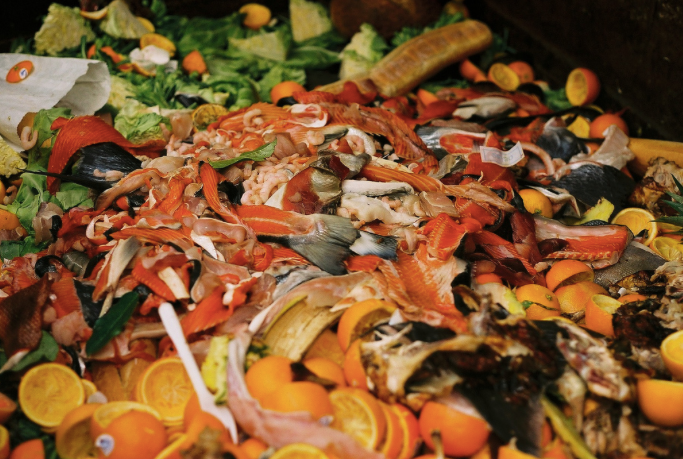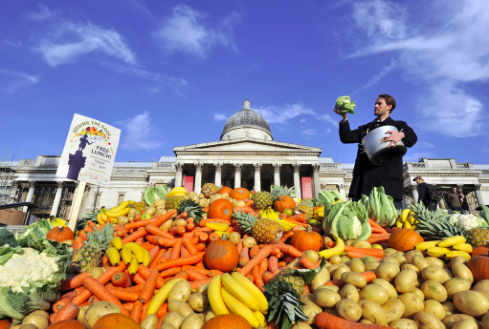About one month ago, I found myself for the first time with my hands deep in a smelly, dark dumpster looking for potential ingredients for my next dinner. Not because I’m forced to or because I enjoy the smell of garbage, I was curious to see how much food a regular Swedish supermarket tosses after closing time. There was a lot. A lot more than what seemed reasonable.
Considering that 795 million people around the world go to bed hungry, and that food production demands a massive use of resources, tossing food seems not only weird and wasteful but also dangerous for the climate.
Food waste is a global problem, not only present in wealthy Western countries but also nations like China, India and other countries where parts of the population suffer from hunger.
 In 2011, a report from the Food and Agriculture Organization of the United Nations (FAO) estimated that “roughly one-third of food produced for human consumption is lost or wasted globally, which amounts to about 1.3 billion tons per year.”
In 2011, a report from the Food and Agriculture Organization of the United Nations (FAO) estimated that “roughly one-third of food produced for human consumption is lost or wasted globally, which amounts to about 1.3 billion tons per year.”
However, the reasons for food waste are various and depend on the country’s economic status.
According to the FAO report, low-income countries mainly throw away food early in the production due to premature harvesting, lack of facilities to preserve the fresh food or too few places with storage and sales opportunities
In industrialized countries, a lot of food is wasted because the production exceeds the demand and in high- and medium-income countries, most waste happens at the consumption stage where food is simply tossed even if it is still edible. The food can be discarded by suppliers or consumers because it does not meet certain aesthetic standards. Also, the demand for a varied assortment of food leads retail chains to buy more than what they can sell.
“Retail stores need to order a variety of food types and brands from the same manufacturer to get beneficial prices […] A wide range of products does, however, increase the likelihood of some of them reaching their “sell-by” date before being sold, and thereby wasted,” the FAO report states.
It adds that “at the consumer level, insufficient purchase planning and expiring ‘best-before-dates’ also cause large amounts of waste, in combination with the careless attitude of those consumers who can afford to waste food.”
Yes. In high-income countries, we can afford to waste food. Consumers – and thereby supermarkets – can reject groceries because they are too crooked or too small.
The FAO report describes how Tristram Stuart, a British anti-food waste campaigner, visited a carrot farm in Yorkshire that sent 25-30 percent of the production to feed livestock just because they didn’t meet the retail chains’ aesthetic demands:
“In the packing house, all carrots passed through photographic sensor machines, searching for aesthetic defects. Carrots that were not bright orange, had…[a] blemish or were broken were swept off.”
Sounds weird? It definitely is. But it is also the simple consequence of consumerism. It is the belief that consuming more is economically beneficial for society. But this increases the risk of overproduction and makes it easier for us, the consumers, to be picky with our grocery shopping.
As Tristram Stuart puts it: “There is an enormous buffer in the West between us and hunger.”

Not only is this a Western problem, but the environmental impact of food waste affects both rich and poor countries. Overproduction of food affects the world’s CO2 emissions.
In another document on “Food wastage footprint & Climate Change”, FAO writes that “if food wastage were a country, it would be the third largest emitting country in the world.”
Landfills produce methane that causes global warming at a higher rate than carbon emissions. In landfills, perfectly edible, though aesthetically imperfect, food spoils and warms the planet.
The world’s blue water footprint – water used for agriculture, industry and domestic use – also increases when we waste food. FAO concluded that food wastage from agricultural production leaves a water footprint equivalent to the annual water discharge of the Russian river Volga – about 250 km3.
However, since food waste is a result of human behavior, humans also have the power to stop what we have started. This is the opinion of Selina Juul, founder of the Danish movement against food waste, which is simply called: “Stop Wasting Food.”
At a TED x Copenhagen in 2012, she said: “I was born in Moscow. When I came to the West 19 years ago, I was shocked to see the amount of food. But I was also shocked to see the amount of food people wasted without giving it a second thought.”

The “Stop Wasting Food” movement works to change the Danish consumers’ behavior and has helped the country reduce its food waste by 25 percent. For instance, Selina Juul has published a cookbook about leftovers and made a retail chain create a quantity discount in their shops.
Similar anti-food waste movements exist all over the world from Ireland to Singapore and they all have advice for what we as consumers can do to limit our food waste.
For instance, buy and cook just enough food, store it properly so it lasts longer and plan your meals so you’re less likely to buy too much.
According to Selina Juul, it is just a question of using what she calls “the power of the consumer.”
“It is quite simple,” she states. “Stop being a consumer zombie. You are in control of your grocery shopping. It is not controlling you.”
Even though it might seem unmanageable for one person to affect the whole supply chain from the supermarkets to the food producers, Selina Juul believes that our everyday actions will have an effect in the long run:
“Of course we cannot send the leftovers from our plate to the starving people in Africa but the fact that we in the West are over-consuming, and the fact that we throw food away, is affecting the global demand for food and the global food prices. So, what we do here does affect people on the other side of the planet.”
By Ida Scharla Løjmand
Photo Credit:
Jon Bunting, Creative Commons Attribution 2.0 Generic (CC BY 2.0)
Taz, Creative Commons Attribution 2.0 Generic (CC BY 2.0)










